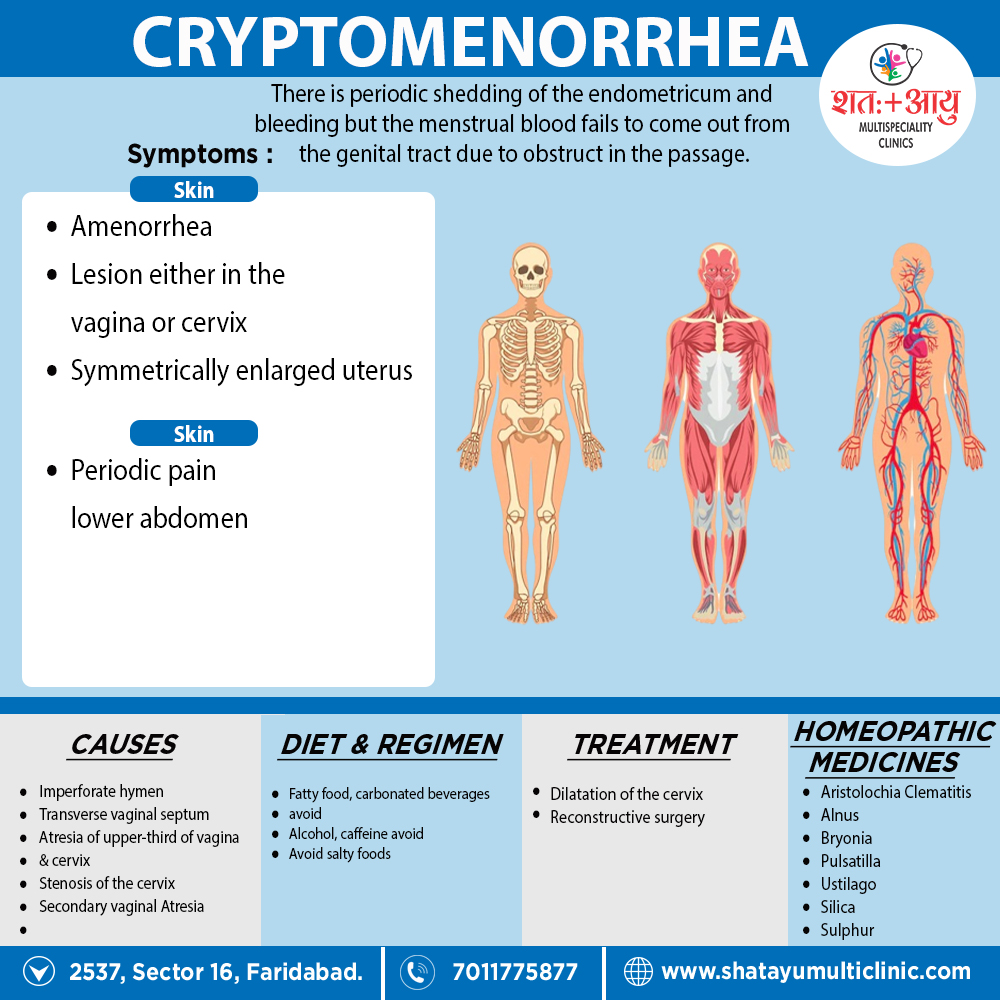Homeopathic Treatment of Cryptomenorrhea
Homeopathy treats the person as a whole. It means that homeopathic treatment focuses on the patient as a person, as well as his pathological condition. The homeopathic medicines selected after a full individualizing examination and case-analysis.
Which includes
- The medical history of the patient,
- Physical and mental constitution,
- Family history,
- Presenting symptoms,
- Underlying pathology,
- Possible causative factors etc.
A miasmatic tendency (predisposition/susceptibility) also often taken into account for the treatment of chronic conditions.
What Homoeopathic doctors do?
A homeopathy doctor tries to treat more than just the presenting symptoms. The focus is usually on what caused the disease condition? Why ‘this patient’ is sick ‘this way’?
The disease diagnosis is important but in homeopathy, the cause of disease not just probed to the level of bacteria and viruses. Other factors like mental, emotional and physical stress that could predispose a person to illness also looked for. Now a days, even modern medicine also considers a large number of diseases as psychosomatic. The correct homeopathy remedy tries to correct this disease predisposition.
The focus is not on curing the disease but to cure the person who is sick, to restore the health. If a disease pathology not very advanced, homeopathy remedies do give a hope for cure but even in incurable cases, the quality of life can greatly improve with homeopathic medicines.
Medicine of Cryptomenorrhea:
Clematis:
Brown discharge, watery flow. In detail, Eczema of the vulva. Sensual itching, aggravated before menses, on the other hand, ameliorated during menses, aggravated after menses. Menses absent, late or short, Blood especially, black, with clotting. Varicocele. Dysmenorrhea. Infrequent menses. Amenorrhea. Metritis. After-pains with laryngitis. Lastly, Vaginitis.
Agnus:
Clinical This drug has been used especially for strumous disorders, enlarged submaxillary glands, leucorrhoeas, with erosions of cervix, which bleed easily, amenorrhoea, burning pain from back to pubis.
Bryonia:
Sticking pains in the region of the liver on touch, coughing or breathing. Specifically, Symptoms of inflammation of the liver and of the diaphragm. Abdomen distended. Additionally, A feeling of something heavy lying in the abdomen. Movements. loud either rumbling or a gurgling and soreness and dragging downward.
Pulsatilla:
Suited to patients of a mild also easy disposition. In detail, Pain in lower part of abdomen and across the small of the back; giddiness, fullness about the head and eyes; chilliness, cold hands and feet; sour taste in the mouth after eating; nausea also vomiting; loss of appetite, with desire for acids, and palpitation; disinclination for exercise, alternate laughing and crying, sadness, melancholy, painfulness of the head; the symptoms are worse in the afternoon and before midnight; whereas symptoms are better in the open air while exercising. pains frequently change from one place to another.
Ustilago:
It is specifically indicated in Cryptomenorrhea. Tenderness of the left ovary, with pain and swelling. Basically, A distress referred to the mouth of the uterus. Yellow, offensive leucorrhoea. Menstruation free, bright, not coagulated. Uterine hemorrhage, bright, thin, with soft, spongy uterus, pain extending to the knees; with tenderness especially, of left ovary. Ovarian neuralgia, left. Membranous dysmenorrhoea. Pain shooting down the legs. Persistent uterine hemorrhage, with oozing of dark blood in clots. All in all, Pain in the left mammary region between periods, with ovarian congestion and burning pains.
Silica:
Colicky pains in the lower abdomen, with straining and increased pain during stool. Constantly hard, greatly distended. Feels thick and heavy like a weight.
Sulphur:
After Puls, when the latter has been insufficient, and in all cases which drag, especially if the patient complains of heat in the head, giddiness, and palpitation, short breath, loss of appetite, sickness after eating, loss of flesh, and depression.[3]

